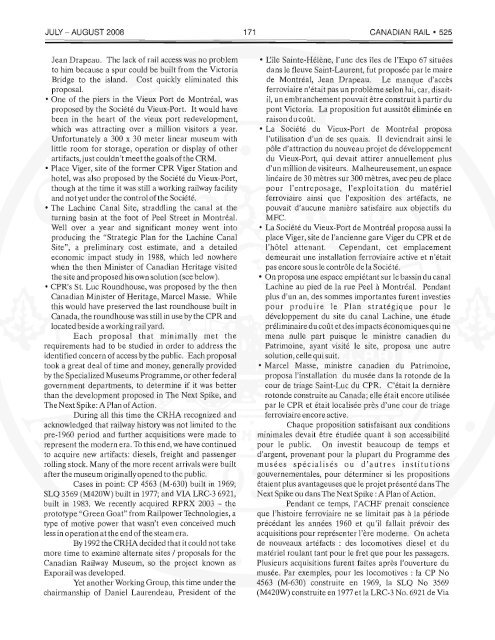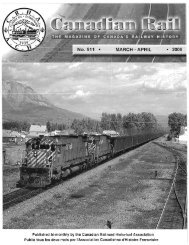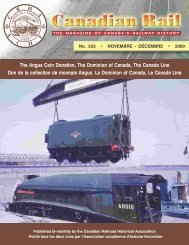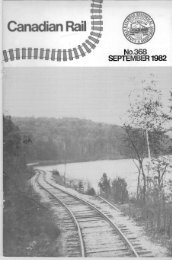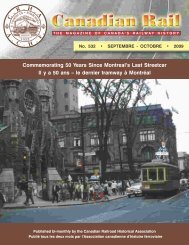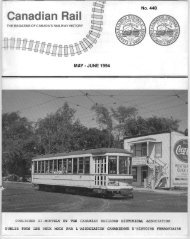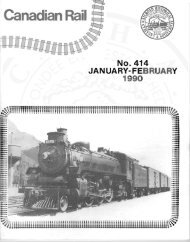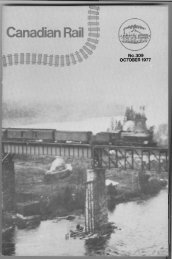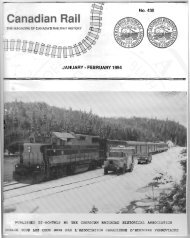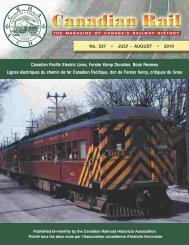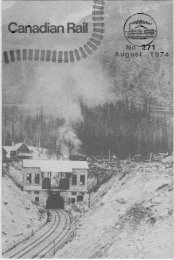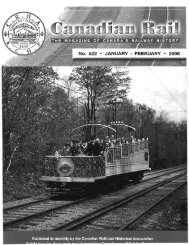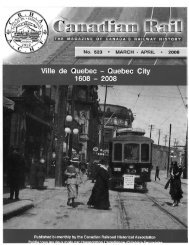Canadian Rail_no525_2008 - Le musée ferroviaire canadien
Canadian Rail_no525_2008 - Le musée ferroviaire canadien
Canadian Rail_no525_2008 - Le musée ferroviaire canadien
You also want an ePaper? Increase the reach of your titles
YUMPU automatically turns print PDFs into web optimized ePapers that Google loves.
JULY - AUGUST <strong>2008</strong><br />
171 CANADIAI\I RAIL 0 525<br />
Jean Drapeau. The lack of rail access was no problem<br />
to him because a spur could be built from the Victoria<br />
Bridge to the island. Cost quickly eliminated this<br />
proposal.<br />
o One of the piers in the Vieux Port de Montreal, was<br />
proposed by the Societe du Vieux-Port. It would have<br />
been in the heart of the vieux port redevelopment,<br />
which was attracting over a million visitors a year.<br />
Unfortunately a 300 x 30 meter linear museum with<br />
little room for storage, operation or display of other<br />
artifacts,just couldn't meet the goals of the CRM.<br />
o Place Viger, site of the former CPR Viger Station and<br />
hotel, was also proposed by the Societe du Vieux-Port,<br />
though at the time it was still a working railway facility<br />
and not yet under the control of the Societe.<br />
o The Lachine Canal Site, straddling the canal at the<br />
turning basin at the foot of Peel Street in Montreal.<br />
Well over a year and significant money went into<br />
producing the "Strategic Plan for the Lachine Canal<br />
Site", a preliminary cost estimate, and a detailed<br />
economic impact study in 1988, which led nowhere<br />
when the then Minister of <strong>Canadian</strong> Heritage visited<br />
the site and proposed his own solution (see below).<br />
o CPR's St. Luc Roundhouse, was proposed by the then<br />
<strong>Canadian</strong> Minister of Heritage, Marcel Masse. While<br />
this would have preserved the last roundhouse built in<br />
Canada, the roundhouse was still in use by the CPR and<br />
located beside a working rail yard.<br />
Each proposal that minimally met the<br />
requirements had to be studied in order to address the<br />
identified concern of access by the public. Each proposal<br />
took a great deal of time and money, generally provided<br />
by the Specialized Museums Programme, or other federal<br />
government departments, to determine if it was better<br />
than the development proposed in The Next Spike, and<br />
The Next Spike: A Plan of Action.<br />
During all this time the CRHA recognized and<br />
acknowledged that railway history was not limited to the<br />
pre-1960 period and further acquisitions were made to<br />
represent the modern era. To this end, we have continued<br />
to acquire new artifacts: diesels, freight and passenger<br />
rolling stock. Many of the more recent arrivals were built<br />
after the museum originally opened to the public.<br />
Cases in point: CP 4563 (M-630) built in 1969;<br />
SLQ 3569 (M420W) built in 1977; and VIA LRC-3 6921,<br />
built in 1983. We recently acquired RPRX 2003 - the<br />
prototype "Green Goat" from <strong>Rail</strong>power Technologies, a<br />
type of motive power that wasn't even conceived much<br />
less in operation at the end of the steam era.<br />
By 1992 the CRHA decided that it could not take<br />
more time to examine alternate sites / proposals for the<br />
<strong>Canadian</strong> <strong>Rail</strong>way Museum, so the project known as<br />
Exporail was developed.<br />
Yet another Working Group, this time under the<br />
chairmanship of Daniel Laurendeau, President of the<br />
o Clie Sainte-Helene, l'une des iles de l'Expo 67 situees<br />
dans Ie fleuve Saint-Laurent, fut proposee par Ie rna ire<br />
de Montreal, Jean Drapeau. <strong>Le</strong> manque d'acces<br />
<strong>ferroviaire</strong> n'etait pas un probleme selon lui, car, disaitii,<br />
un embranchement pouvait etre construit a partir du<br />
pont Victoria. La proposition fut aussitOt eliminee en<br />
raison du couto<br />
o La Societe du Vieux-Port de Montreal proposa<br />
I'utilisation d'un de ses quais. II deviendrait ainsi Ie<br />
pole d'attraction du nouveau projet de developpement<br />
du Vieux-Port, qui devait attirer annuellement plus<br />
d'un million de visiteurs. Malheureusement, un espace<br />
lineaire de 30 metres sur 300 metres, avec peu de place<br />
pour I'entreposage, I'exploitation du materiel<br />
<strong>ferroviaire</strong> ainsi que l'exposition des artefacts, ne<br />
pouvait d'aucune maniere satisfaire aux objectifs du<br />
MFC.<br />
o La Societe du Vieux-Port de Montreal proposa aussi la<br />
place Viger, site de l'ancienne gare Viger du CPR et de<br />
l'hotel attenant. Cependant, cet emplacement<br />
demeurait une installation <strong>ferroviaire</strong> active et n'etait<br />
pas encoresous Ie controle dela Societe.<br />
o On proposa une espace empietant sur Ie bassin du canal<br />
Lachine au pied de la rue Peel a Montreal. Pendant<br />
plus d'un an, des sommes importantes furent investies<br />
pour produire Ie Plan strategique pour Ie<br />
developpement du site du canal Lachine, une etude<br />
preliminaire du cout et des impacts economiques qui ne<br />
men a nulle part puisque Ie ministre <strong>canadien</strong> du<br />
Patrimoine, ayant visite Ie site, proposa une autre<br />
solution, celie qui suit.<br />
o Marcel Masse, ministre <strong>canadien</strong> du Patrimoine,<br />
proposa I'installation du musee dans la rotonde de la<br />
cour de triage Saint-Luc du CPR. C'etait la derniere<br />
rotonde construite au Canada; elle eta it encore utilisee<br />
par Ie CPR et etait localisee pres d'une cour de triage<br />
<strong>ferroviaire</strong> encore active.<br />
Chaque proposition satisfaisant aux conditions<br />
minimales devait etre etudiee quant a son accessibilite<br />
pour Ie public. On investit beaucoup de temps et<br />
d'argent, provenant pour la plupart du Programme des<br />
musees specialises ou d ' autres institutions<br />
gouvernementales, pour determiner si les propositions<br />
etaient plus avantageuses que Ie projet presente dans The<br />
Next Spike ou dans The Next Spike :A Plan of Action.<br />
Pendant ce temps, l'ACHF prenait conscience<br />
que I'histoire <strong>ferroviaire</strong> ne se limitait pas a la periode<br />
precedant les annees 1960 et qu 'il fallait prevoir des<br />
acquisitions pour representer l'ere moderne. On acheta<br />
de nouveaux artefacts : des locomotives diesel et du<br />
materiel roulant tant pour Ie fret que pour les passagers.<br />
Plusieurs acquisitions furent faites apres I'ouverture du<br />
musee. Par exemples, pour les locomotives: la CP No<br />
4563 (M-630) construite en 1969, la SLQ No 3569<br />
(M420W) construite en 1977 et la LRC-3 No. 6921 de Via


